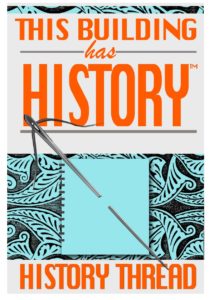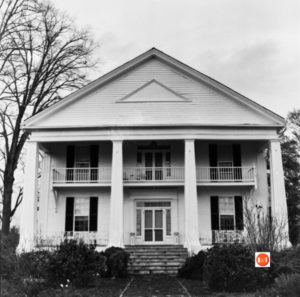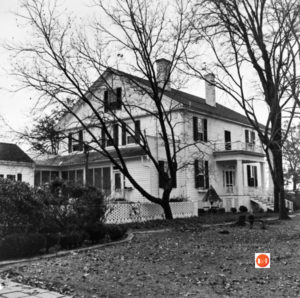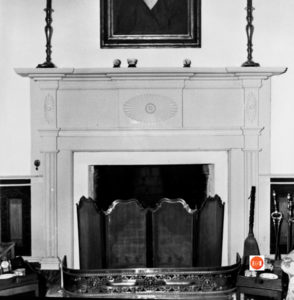“An impressive planter’s home constructed by local contractor, Mr. Henry Jones.”
City Directories and History: This lovely antebellum home is listed on the National Register of Historic Places.

Eden Hall courtesy of the S.C. Dept. of Archives and History
Eden Hall, reputedly constructed ca. 1854, is a Greek Revival plantation house with Egyptian influences. The house was built for Dr. John Wardlaw Hearst and, according to family tradition, was designed by Henry Jones, an Atlanta architect. Eden Hall derives its significance from its eclectic blend of architectural styles, and from its association with Dr. Hearst, who attained recognition in the fields of politics (state representative), agriculture, and education. The house is a large two-and one-half-story, white frame house resting on a high brick foundation. The medium gable, composition roof, has four interior chimneys and a boxed cornice. The heavily pedimented, two story front portico is supported by four large stucco-over-brick pillars. The use of obelisk style pillars, with their inclined taper from cavetto-capital to a gradually widening base, and the incised panels, which repeat the basic form of the pillars, suggest an Egyptian influence. The temple form is frequently reiterated in Eden Hall, from the exterior pedimented gable with a triangular panel inset in a broad tympanum, to the interior door surrounds and architraves. South of the main house is a formal garden, which according to family tradition, was designed by an English landscape architect. To the east of the house is the original well and canopy, adjacent to a modern, brick pump house. Listed in the National Register September 23, 1980. [Courtesy of the SC Dept. of Archives and History]
Eden Hall. Henry Jones designed Eden Hall for Dr. John Wardlaw Hearst. Dr. Hearst married Anne Chiles of Cedar Springs in 1835 and became a prominent physician, state legislator and trustee for Erskine College, founded by his cousin Dr. Ebenezer Erskine Presly. In 1847, Dr. Hearst sold his father’s home and moved with his wife to a farm cabin on Charleston Road. The couple lived in the cabin seven years until Eden Hall adjacent was completed. The home’s brick foundation supports sills hand sawed and hewed from virgin pine trees from the plantation. Joists, framing, lattices, and flooring in the home were likewise cut locally.
The first Hearsts to arrive in America had come from Scotland in the seventeenth century. They were militant Presbyterian Covenanters, fiercely anti-Catholic, pledged to their religion as the only legitimate one in Scotland and the British Isles. The name was spelled Hyrst, then Hurst and later Hearse. Descendants of the Scottish Hearsts made their way to the Hard Labor Section in 1766. Famed William Randolph Hearst was descended from the family. [Written and contributed to R&R by Bob Edmonds, 2015]
Stay Connected
Explore history, houses, and stories across S.C. Your membership provides you with updates on regional topics, information on historic research, preservation, and monthly feature articles. But remember R&R wants to hear from you and assist in preserving your own family genealogy and memorabilia.
Visit the Southern Queries – Forum to receive assistance in answering questions, discuss genealogy, and enjoy exploring preservation topics with other members. Also listed are several history and genealogical researchers for hire.
User comments welcome — post at the bottom of this page.
Please enjoy this structure and all those listed in Roots and Recall. But remember each is private property. So view them from a distance or from a public area such as the sidewalk or public road.
Do you have information to share and preserve? Family, school, church, or other older photos and stories are welcome. Send them digitally through the “Share Your Story” link, so they too might be posted on Roots and Recall.
Thanks!
IMAGE GALLERY – Blythe Collection, 1982
Dr. John Wardlaw Hearst, 1813-1873
John Wardlaw Hearst, son of “Hard Labor John” was an outstanding man. He graduated in medicine from Miami University in Oxford, Ohio. The story was told that while a student he asked to join the Presbyterian Church in Oxford and was refused membership because his father owned slaves.
He returned to his native community and in 1835 married Ann Chiles, 1814-1891, daughter of John Chiles,* no children. They first lived at Sylvania with his parents, then had a home not far from Hard Labor Creek. In the late 1840’s or early 1850’s, Dr. Hearst built “Eden Hall,” a fine country home. It is on highway 221 in McCormick County and is owned by Mrs. F.E. Grier of Greenwood.
Along with an extensive medical practice, Dr. Hearst was a planter on a large scale, notable for his progressive methods. He tried out improved farm implements such as a subsoil plow and had good crops even in dry seasons. He experimented with seeds to develop the best strains, and he had purebred livestock, a relative rarity at the time. His place was a private “experiment station” and a profitable one. Besides Eden Hall, Dr. Hearst had a large plantation in south Georgia. He represented Abbeville in the state legislature. When the Confederate War began he enlisted as a private, but served as surgeon for his company. After a year he was detached for duty at home, but in the last part of the war was captain of a company stationed on the South Carolina coast.
Often told to illustrate Dr. Hearst’s character was the story of a verbal agreement he made to sell a tract of land to W.B. (Squire Billy) Dorn who discovered gold on the property. Dorn reported his find, expecting the agreement to be called off, or the price to be increased. Dr. Hearst is reported to have said, “You pay me what I agreed to take for the land and no more. I don’t care if you get a million dollars out of it. I hope you will.” Squire Billy almost fulfilled that hope. He had receipts from the Federal Mint in Philadelphia for over $900,000 in gold before the mine’s vein ran out. The Dorn gold mine site is in McCormick County.
While Dr. Hearst was “land poor” after the Confederate War, his farming methods enabled him to get along better than most of his neighbors. He left his property to his wife for her lifetime, then two-thirds of the estate was willed to Erskine College.
Information from: Greenwood County Sketches by Margaret Watson, 1982, p. 255












